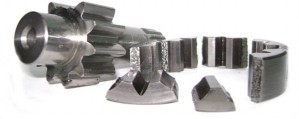

InsaneHydraulics - Sergiy Sydorenko © 2009-2010 All Ridghts Reserved





When I built this blog, I was very reluctant to
create any pages devoted to basic hydraulics, mainly
because the web is full of articles on the topic, but the thing is - if two
people want to have any kind of civilized discussion they MUST
a) respect each other's opinion, and
b) agree upon basic assumptions
Which means that before talking any hydraulics, we
must agree upon certain self-evident and taken for granted axioms,
serving as starting points for deducing and inferring further
assumptions and conclusions. There is no point in explaining the notion
of equator to a person who is convinced that the Earth is flat.
Therefore I am putting below a small list of things I consider to be
hydraulics axioms:
1. The most important of all - Pumps create FLOW,
not pressure. Pressure is created by the resistance to the existing
flow.
This is LOGICAL assumption, not fully scientific. It means that a pump
alone CAN NOT create pressure in a system, you must always have
a "pump"(or its analogue, like accumulator, loaded cylinder,
oil-head, etc.) and some kind of a "flow-resistor". The purpose
of a pump is to create oil flow, the purpose of an actuator is to
convert the motion of the oil into useful work, during this process and due
to the physical properties of the oil pressure will build up in the circuit IN
ACCORDANCE to the actuator's "demand", not in accordance to the pump's
settings or size. Accepting this simple principle is the easiest way to troubleshoot a hydraulic system.
(Short off-topic elaboration) Imagine yourself poking a sack of manure with a
stick. In this example your hand is the pump, the stick is the oil in a
hose, and the stick's internal stress due to its compression is the oil
pressure. The bigger the sack or the faster its acceleration, the
bigger is the stick's internal stress. But if instead of pushing the manure you
try to push "air", you will not be able to create any internal stress
inside the stick, no matter how strong a redneck you are.
So, when someone tells you that a pump does not "give
pressure", it means that at the given flow rate a leakage factor
existing in the system is so big, that the system's pressure can not go higher than
"x" bar. This leakage can be internal (busted pump) or external (broken
relief valve, burst hose, disconnected line pointing at your foreman,
for example).
It is interesting that if you know a pump's
displacement and the maximum torque a prime mover can provide, you can
calculate the maximum theoretical pressure the system can
build by stalling the prime mover (yeah, I know, but let us imagine for
a second it is a magical mover, ok?) Although in this case you
will not see any flow, you will still need the mover to maintain
constant torque to keep the system pressurized. The same thing happens
in a closed at the bottom vertical tube filled with oil, which can be
regarded as gravitation-moved pump in stalled condition. If you measure
the pressure at the bottom you will read the head pressure, but at the
instant you open the bottom, the pressure will drop to
zero, with the oil flow coming out unrestricted. (End of short off-topic elaboration)
2. The main purpose of hydraulic systems is energy
transfer from the prime mover to the actuator for it to produce useful
work. The quantity of energy a prime mover (motor) produces in a given
period of time is power. A prime mover has power limits, so work speed
will have limits too.
All three forms of energy are present in a
hydraulic system (potential, kinetic, heat (simplified, I know)), and
all the energy you input into the system will come out as useful work
(good, we want more of this) and heat (bad, we don't want this in
excess), and some noise (bz-z-z-z-z-z-z-z). Despite being compact,
hydraulic systems are not very efficient, so heat dissipation should
always be considered. Whenever there is a pressure drop ( oil passing
from high pressure area to low pressure area) without creating useful work, heat WILL be generated.
3. Pressure means force (torque), flow means
speed.(rpm), NOT to be confused. Flow times pressure means power. So if
you need more force, increase pressure, if you need more speed,
increase flow, if you need both, install a bigger motor/pump unit...
4. Oil will not go where you want it to go, the
rebellious fluid will always take path of the least resistance.
Well, that's about it! These are the hydraulics
fundamentals you should accept to ensure efficient troubleshooting and
understanding of a hydraulic system. And as far as the troubleshooting
itself goes, consider the following:
1. Do not trust anybody and question everything, even the obvious.
2. Anything you do should make sense to you, not the machine's owner.
3. Open your mind, troubleshooting hydraulic systems often resembles detective's work.
4. Make all your experiences (both good and bad) educational, learn from your mistakes.
Visit The Library for basic hydraulics related information and links.




